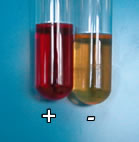 Methyl
Red / Voges-Proskauer (MR/VP)
Methyl
Red / Voges-Proskauer (MR/VP)
 This test is used to determine which fermentation pathway is used
to utilize glucose. In the mixed acid fermentation pathway, glucose
is fermented and produces several organic acids (lactic, acetic,
succinic, and formic acids). The stable production of enough acid
to overcome the phosphate buffer will result in a pH of below
4.4. If the pH indicator (methyl red) is added to an aliquot of
the culture broth and the pH is below 4.4, a red color will appear
(first picture, tube on the left). If the MR turns yellow, the
pH is above 6.0 and the mixed acid fermentation pathway has not
been utilized (first picture, tube on the right). The 2,3 butanediol
fermentation pathway will ferment glucose and produce a 2,3 butanediol
end product instead of organic acids. In order to test this pathway,
an aliquot of the MR/VP culture is removed and a-naphthol
and KOH are added. They are shaken together vigorously and set
aside for about one hour until the results can be read. The Voges-Proskauer
test detects the presence of acetoin, a precursor of 2,3 butanediol.
If the culture is positive for acetoin, it will turn “brownish-red
to pink” (tube on the left in the second picture). If the
culture is negative for acetoin, it will turn “brownish-green
to yellow” (tube on the left in the second picture). Note:
A culture will usually only be positive for one pathway:
either MR+ or VP+. Escherichia coli is MR+ and VP-. In
contrast, Enterobacter aerogenes and Klebsiella pneumoniae are MR- and VP+. Pseudomonas aeruginosa is a glucose
nonfermenter and is thus MR- and VP-.
This test is used to determine which fermentation pathway is used
to utilize glucose. In the mixed acid fermentation pathway, glucose
is fermented and produces several organic acids (lactic, acetic,
succinic, and formic acids). The stable production of enough acid
to overcome the phosphate buffer will result in a pH of below
4.4. If the pH indicator (methyl red) is added to an aliquot of
the culture broth and the pH is below 4.4, a red color will appear
(first picture, tube on the left). If the MR turns yellow, the
pH is above 6.0 and the mixed acid fermentation pathway has not
been utilized (first picture, tube on the right). The 2,3 butanediol
fermentation pathway will ferment glucose and produce a 2,3 butanediol
end product instead of organic acids. In order to test this pathway,
an aliquot of the MR/VP culture is removed and a-naphthol
and KOH are added. They are shaken together vigorously and set
aside for about one hour until the results can be read. The Voges-Proskauer
test detects the presence of acetoin, a precursor of 2,3 butanediol.
If the culture is positive for acetoin, it will turn “brownish-red
to pink” (tube on the left in the second picture). If the
culture is negative for acetoin, it will turn “brownish-green
to yellow” (tube on the left in the second picture). Note:
A culture will usually only be positive for one pathway:
either MR+ or VP+. Escherichia coli is MR+ and VP-. In
contrast, Enterobacter aerogenes and Klebsiella pneumoniae are MR- and VP+. Pseudomonas aeruginosa is a glucose
nonfermenter and is thus MR- and VP-.
 Methyl
Red / Voges-Proskauer (MR/VP)
Methyl
Red / Voges-Proskauer (MR/VP)This test is used to determine which fermentation pathway is used to utilize glucose. In the mixed acid fermentation pathway, glucose is fermented and produces several organic acids (lactic, acetic, succinic, and formic acids). The stable production of enough acid to overcome the phosphate buffer will result in a pH of below 4.4. If the pH indicator (methyl red) is added to an aliquot of the culture broth and the pH is below 4.4, a red color will appear (first picture, tube on the left). If the MR turns yellow, the pH is above 6.0 and the mixed acid fermentation pathway has not been utilized (first picture, tube on the right). The 2,3 butanediol fermentation pathway will ferment glucose and produce a 2,3 butanediol end product instead of organic acids. In order to test this pathway, an aliquot of the MR/VP culture is removed and a-naphthol and KOH are added. They are shaken together vigorously and set aside for about one hour until the results can be read. The Voges-Proskauer test detects the presence of acetoin, a precursor of 2,3 butanediol. If the culture is positive for acetoin, it will turn “brownish-red to pink” (tube on the left in the second picture). If the culture is negative for acetoin, it will turn “brownish-green to yellow” (tube on the left in the second picture). Note: A culture will usually only be positive for one pathway: either MR+ or VP+. Escherichia coli is MR+ and VP-. In contrast, Enterobacter aerogenes and Klebsiella pneumoniae are MR- and VP+. Pseudomonas aeruginosa is a glucose nonfermenter and is thus MR- and VP-.



0 Comments:
Post a Comment